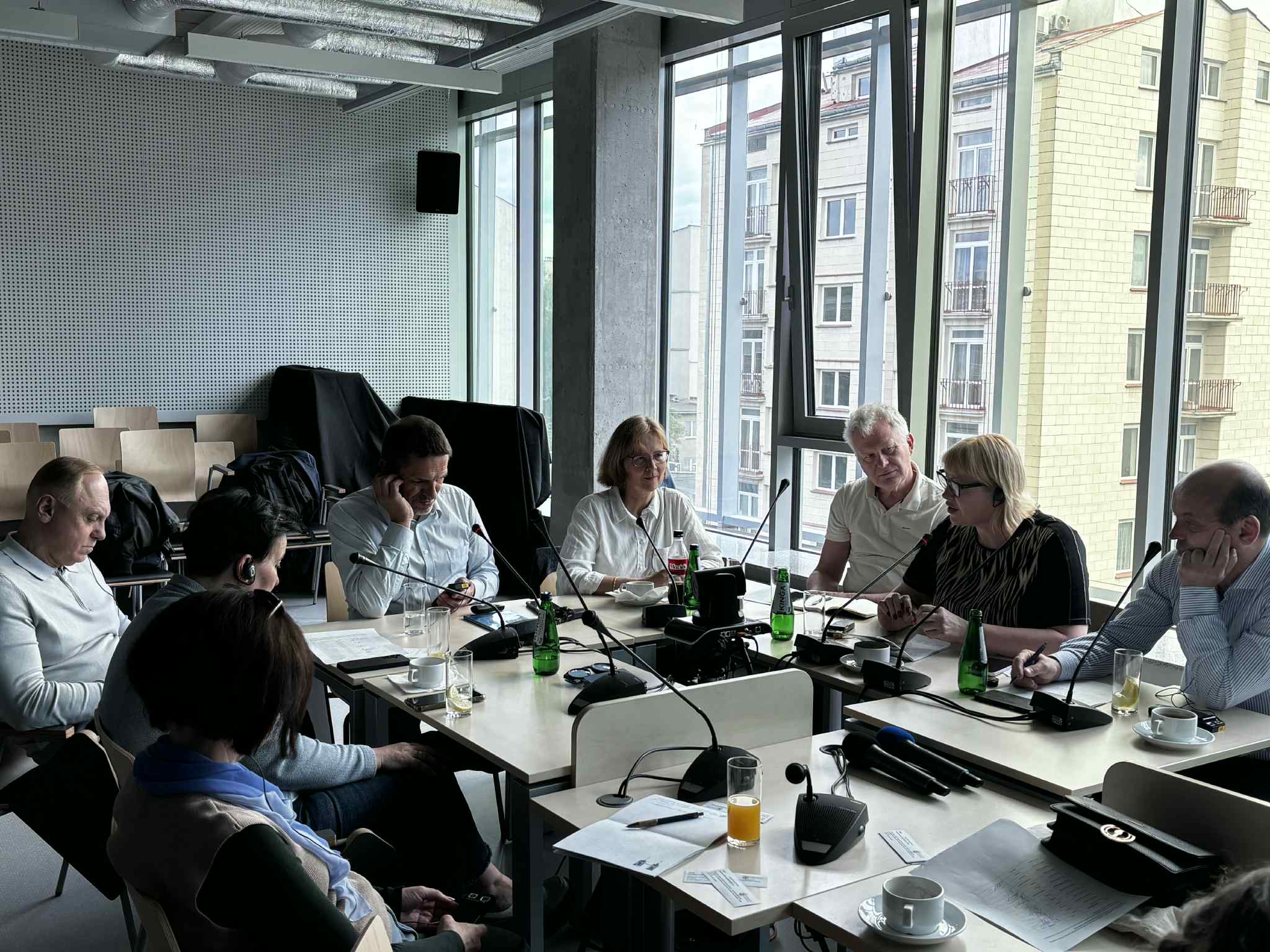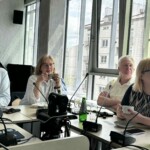Poland: Elections, parties and rivalry mechanisms/Ukraine: challenges to the party system and political legitimacy

12 06 2025
On 12 June 2025, the fourth seminar of the series „The political system at work” was held, devoted to the analysis of electoral and party systems in Poland and Ukraine. In line with the established way of working, Thursday’s meeting also took the form of a two-expert panel. Two papers were presented: by Professor Jarosław Flis of the Jagiellonian University, entitled “The Polish electoral system”, and by Professor Jarosław Flis of the Jagiellonian University, entitled “The Polish electoral system”. ‘The Polish electoral system’ and Professor Anatoliy Romaniuk of Ivan Franko National University in Lviv ‘Assessment of the state of development of political parties functioning in Ukraine’.
Electoral systems and party structures in Poland and Ukraine are shaped at the interface of ideological rivalry, institutional constraints and changing social expectations. In Poland, the political structure stabilises around five groupings, while in Ukraine we observe a frozen party system and a deficit of real political representation.
Poland: Elections, parties and rivalry mechanisms
In his presentation, Prof. Jarosław Flis discussed the impact of the proportional law in force in Poland on the dynamics of the party system, pointing out, among other things, the so-called progressive proportionality effect, which favours the largest groupings. The 460 MPs are elected in 41 multi-mandate electoral districts and seats are allocated using the D’Hondt method. The electoral thresholds (5% for parties, 8% for coalitions) effectively limit the fragmentation of the political scene, while at the same time rewarding parties able to mobilise a wider electorate. The speaker pointed out that there is party rivalry along a new axis: top-down, which replaces the classic left-right divide. Instead of an ideological dispute (market vs community), tensions between elitism and mass representation dominate. Opposition and ruling parties exchange power within a simplified message – without fundamentally changing the systemic foundations.
In the remainder of the paper, Prof. Flis touched on the differences in elections to governing bodies at different levels. The greatest proportionality between the number of votes and the number of seats is maintained in elections to the European Parliament. In his speech, the speaker also touched on the important issue of the place a candidate occupies on the list. The first candidate on the list is likely to receive the most support. There is also a phenomenon like voting for a kind of ‘celebrity’, i.e. a person who is widely recognised. Moreover, parties also take into account possible rivalry between local candidates when composing their lists. The speaker pointed out that such phenomena as “shooters” (candidates with a strong personal mandate) or “solicitors” (those remaining on the list) show the complexity of the mechanisms of elite selection and competition management within the party.
In summary, the speaker concluded that although the system provides relative stability, it has its limitations. The voice of a part of the electorate can sometimes be ineffective – in 2015, as many as 15% of votes were cast for committees that did not cross the threshold. At the same time, small parties have learnt the strategy of running as part of the lists of one large party (rather than a coalition) as a result of the lower threshold. Thus, there is some circumvention of the rules by creating “umbrella parties” before the elections.
The paper was followed by a lively discussion, where questions were raised about the representation of voters whose votes were “wasted” by not crossing the threshold, the maintenance of the existing system by larger parties and the resulting reluctance to change the system despite pressure from smaller parties, the transparency of campaign financing, and recommendations for local elections. In the course of the discussion, the example of Slovenia, which uses the single-mandate district method, was cited. Could such a system work in Poland? These and other questions encourage our team to explore further.
Ukraine: challenges to the party system and political legitimacy
In the second part of the seminar, Professor Anatoly Romaniuk presented the situation of political parties in Ukraine, drawing attention to the problem of their ephemeral nature, the populist nature of their programmes and the low level of public trust. At the beginning of the paper, the speaker pointed out that without understanding what kind of institution a political party is in Ukraine, one cannot fully understand the role it plays. The Ukrainian party system was created under conditions of systemic transformation and post-communist heritage. Despite the fact that during the period of perestroika and after the collapse of the Soviet Union, parties were formed by anti-communist activists, they originated precisely from the communist environment. For these reasons, newly established political groups were created according to a pattern that was known earlier: communist, mass parties with many circles, organizing the party field.
In the further part of the speech, Prof. Romaniuk drew attention to the intensification of the process of creating political parties in the 1990s and the adoption of the Act on Political Parties, which defined formal parameters allowing for the recognition of an organization as a full-fledged party. As he pointed out, registration became a sine qua non condition for functioning in the political space, but legalization itself did not go hand in hand with real activity or ideological transparency. Speaking about the changes that were gradually taking place in Ukrainian political life, the speaker noted that politicians of the time were also actively looking towards the West, also observing the Polish political scene. The Ukrainian parties were drifting, democracy began to strengthen, and groups also participated in the formation of government bodies.
However, the speaker emphasized that the lack of knowledge of the programs of their own parties – both by their members and leaders – remains a serious problem. Parties often do not build a lasting organizational structure or real relations with voters. There is a lack of coherent mechanisms of communication and political loyalty, which in the long run leads to the freezing of the party system. Another important issue is the large number of registered political groups. There are over 300 registered parties in Ukraine, but in reality political activity is concentrated around several (currently five) groups present in parliament. Prof. Romaniuk noted that changing the name of a party is a common practice – this is done to mask the emergence of new political entities without the need for re-registration.
The professor also pointed out that parties ignore the need to correct the electoral system and that many of them do not participate in elections, which raises questions about their real status. According to the applicable law, a party maintains political legitimacy if it participates in elections at least once every ten years – also by fielding a candidate in the presidential or early elections. The speech also discussed the formal conditions for recognizing an organization as a party: the obligation to have structures in at least 2/3 of the administrative districts, to provide data on the organizational structure to the Ministry of Justice and to have at least 100 members. This fragment also provides an answer to the later question that arose during the discussion “why are there so many registered parties and why do they change their name?”. Due to this complicated registration procedure, it is popular to sell a registered political group (!), further transform it and create a new election program.
In the final part, the speaker noted that the ongoing war is also a factor destabilizing the functioning of political parties – most structures have suspended their activities, and many men, who predominate in the membership base, have been sent to the front. This phenomenon is also accompanied by a growing program crisis – parties create programs based on social expectations, not coherent visions of the state’s development. The speaker emphasized the need to introduce stricter requirements for political parties – both in terms of organization and program – and pointed to the structural instability of the electoral system in Ukraine, which is the result of its frequent modifications and the lack of a long-term institutional vision.
Reflections and scope for analysis
In Poland, the relative stability of the political system is visible, maintained by institutional solutions, but at the cost of marginalizing smaller groups and reproducing internal tensions. At the same time, parties show reluctance to reform, preferring the status quo, which strengthens their position.
In Ukraine, on the other hand, there is a crisis of party formations as permanent representatives of social interests. The lack of transparency, fragmentation and populism limit the possibility of long-term development of the democratic system.
Electoral systems – both in Poland and Ukraine – show that formal mechanisms can promote stability or, on the contrary, perpetuate the crisis of legitimacy. It seems crucial to find a balance between the representativeness and efficiency of the party system, as well as between the logic of competition and the need for the community rooting of the party in society.



